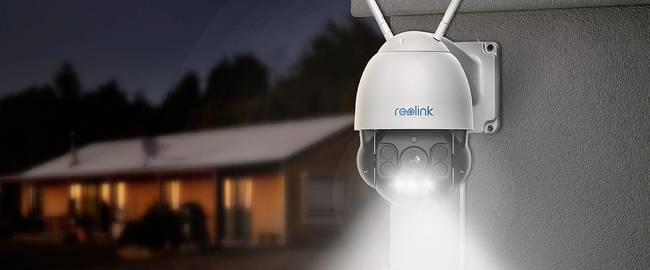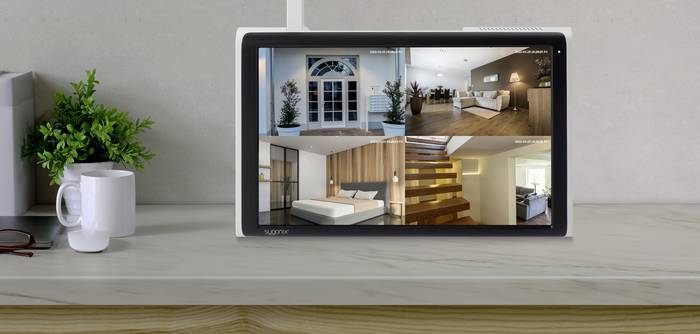All products
Guide
Whether offices, stores, production facilities, warehouses, outbuildings or parking lots: Burglaries, vandalism, fires and water damage in companies cause millions of euros worth of damage every year. Only one in five burglaries is solved - and many smaller companies are reluctant to report serious thefts at all because of the potential negative publicity. The high risk potential requires special loss prevention measures - and every industry has its own security requirements.
In addition, more and more insurance companies are placing high demands on security technology depending on the risk level of a property. Smart security solutions offer automated protection and convenience under the collective term smart home security. They detect smoke and fire, prevent break-ins and warn of leaking water before major damage occurs. Reason enough to think about protecting employees, customers and property. This security guide to wireless alarm systems and smart home devices will help you do just that.
Office equipment, valuables, machines or even data: Whether the burglars are professional gangs or impulsive opportunist thieves is of secondary importance to the companies affected.
As a managing director, manager or owner, you not only have to bear the loss in the form of stolen goods, damaged doors and windows, but also the time-consuming hassle with investigating authorities and insurance companies.
There is also the threat of loss of income until the stolen goods are recovered. If the damage caused by the perpetrators' destructive rage is added to the already high loss, companies are threatened with production stoppages and longer downtimes.
According to Statista, a good 20 percent of SMEs have already been victims of burglary, theft or robbery. Most break-ins take place when nobody is on the premises. However, burglars also strike during the day.
In Germany, there are no statutory regulations for preventive measures to ensure the security of companies. Each company must therefore decide for itself which security concept it applies. The most common method of burglary is to pry open doors or windows. Securing them with mechanical and electronic measures should therefore be a high priority.
It is therefore obvious that if you want to protect your company effectively, you must prevent unauthorized access to the property. Most companies consist of different departments and rooms. These place different demands on security and access control.
Electronic solutions such as intelligent alarm systems, wireless alarm systems and alarm components from the smart home (Internet of Things) sector offer a high level of protection at low cost and are easy to operate.
A wireless alarm system, a smart home alarm system or a wireless alarm system gives you a wide range of options for precisely defining access to the company and within the building and thus limiting risks. Whether a partial solution such as a smart Wi-Fi door intercom, video door intercom with image transmission to your smartphone or modular electronic all-round surveillance for the home: the smart systems combine intelligent hardware and software for the commercial sector. They complement the mechanical building security system and adapt flexibly to your needs and working habits. In combination with video surveillance based on IP cameras, you can significantly increase the security of your company. And the intelligent solutions are also well received by employees. Your advantage: When combining smart devices with IP addresses to create individual security solutions, you are not bound by the requirements of a classic, hard-wired alarm system.
Note: Choose trustworthy providers and products. Use the product description in the Conrad store to find out about the range of functions, smart home technologies and security standards of the respective systems and apps.
An alarm system is an electronic system that triggers an alarm in the event of a break-in or other danger. There are various types of alarm systems, including accessories, which differ in terms of functionality, scope and price.
The variety of smart security systems starts with access control using networked door locks and Wi-Fi door viewers. It continues with indoor surveillance with wireless motion detectors and outdoor security (= monitoring access to the house) via door/window contacts, wireless window handles, wireless window handle locks and glass breakage sensors.
Highly sensitive motion detectors in combination with a smart wireless alarm control panel are a good and cost-effective entry-level solution for building surveillance. Supplementary video surveillance with live image transmission to the smartphone enables monitoring while on the move.
The IP cameras with night vision provide a clear view of what is happening on the premises or in the rooms in coordination with the works council and can record suspicious activities.
Smart Home alarm systems:
A smart home alarm system with app control is similar to a wireless alarm system, but is based on a specific smart home system such as Bosch Smart Home or HomeMatic IP. It not only detects and drives away unwanted guests, but also works together with the other sensors and actuators of the respective provider. This enables automation options via app using standardized protocols such as Z-Wave: for example, closing shutters and blinds in the event of an attempted break-in, locking doors, switching on lights and using smoke detectors as alarm sirens.
Alarm systems and alarm system sets:
These consist of several components that are networked together and have a wireless alarm control panel as the control unit. A starter package, starter set or basic set usually contains sensors for doors and windows, a siren, a remote control and an app for the smartphone.
Wireless alarm systems and wireless alarm system set:
Work in a similar way to an alarm system, but have the advantage that they are completely wireless and can therefore be installed flexibly. The alarm components are connected wirelessly via radio with a long range and blend unobtrusively into the operating environment.
GSM wireless alarm system:
Wireless alarm systems of this type are equipped with an LCD display, a GSM module and a SIM card. This allows the system to communicate via the mobile phone network if other communication channels fail or are blocked.
Access control:
Video doorbells, smart door guards and other access control solutions for the smart home regulate access to certain areas or rooms. They work with RFID transponders, code entry, facial recognition, fingerprint scans or voice commands (Amazon Alexa).
Indoor and outdoor monitoring are two important distinguishing features of modern alarm systems. They fulfill different functions.
Alarm systems with exterior monitoring
Perimeter surveillance prevents break-ins by making access to the building more difficult or deterring them. Sensors such as door and window contacts, glass break detectors or acoustic sensors are used for this purpose, which send a signal to the base station if an attempt is made to penetrate the outer skin. Good: All employees can move around in all rooms even when they are secured without triggering a false alarm. Hand-held transmitters are available for manual alerting in emergency situations. An audible and visual alarm alerts neighbors and passers-by and puts the perpetrator on the run.
Alarm systems with interior monitoring
With indoor surveillance, the areas inside offices and buildings are equipped with wireless infrared motion detectors (PIR motion detectors, PIR sensors) or cameras that are most likely to be traversed by burglars - usually corridors and stairwells. The sensors or cameras send a signal to the control panel when there is a change in the room, which then activates a wireless siren or sends a push notification, for example.
Depending on the structural conditions in the building, a few motion detectors are usually sufficient. The detectors are powered by long-life batteries. Such an alarm system protects the rooms when no one is present.
Note: Combine perimeter surveillance with indoor surveillance using wireless motion detectors and benefit from the advantages of both methods.
There are different approaches to wireless alarm systems, smart home alarm systems and smart home systems in terms of IT security and the handling of personal data. They can be divided into two categories: local solutions and cloud-based solutions.
Local systems
Local solutions are alarm systems and smart home devices in which the control and data remain exclusively in your own network and are not transmitted via the Internet. This has the advantage that personal data is protected from unauthorized access and the function of the devices is guaranteed even if the Internet or a server fails. Disadvantage: You have to do without the convenience of remote control from outside the home that you are used to with smart home systems.
Cloud-based systems
With cloud-based alarm systems, smart home devices are controlled via the internet using an app. A server and cloud storage of the manufacturer takes over the processing and communication. This has the advantage that the devices are easy to install and operate as they can be controlled via an app - with remote control from anywhere. Another advantage is that your company benefits from new functions that the provider makes available online. However, there is also a higher risk, as sensitive data may be stored in the cloud.
Note: Hybrid systems can be operated either locally or with an Internet connection
Wireless smoke alarms warn people present of smoke development and open fire and thus help to prevent the worst from happening. Look out for the Q mark or the Q series as the minimum requirement for quality-tested smoke alarms with high-quality sensors. For a higher safety standard, smart networked smart home smoke alarms with operation via app and the control panel in the smart home are suitable. They warn employees and neighbors with their alarm at an early stage, for example of smoldering fires or flames. This allows those present to get to safety and alert the fire department.
Even more comprehensive protection is provided by a tested fire alarm system: it detects a fire or smoke development and also triggers an alarm. The system should consist of smoke detectors, heat detectors and a control panel. The control panel is usually connected to the internet so that the person responsible can be informed via an app or push message. The system should also be linked to the fire department to ensure rapid assistance in an emergency.

